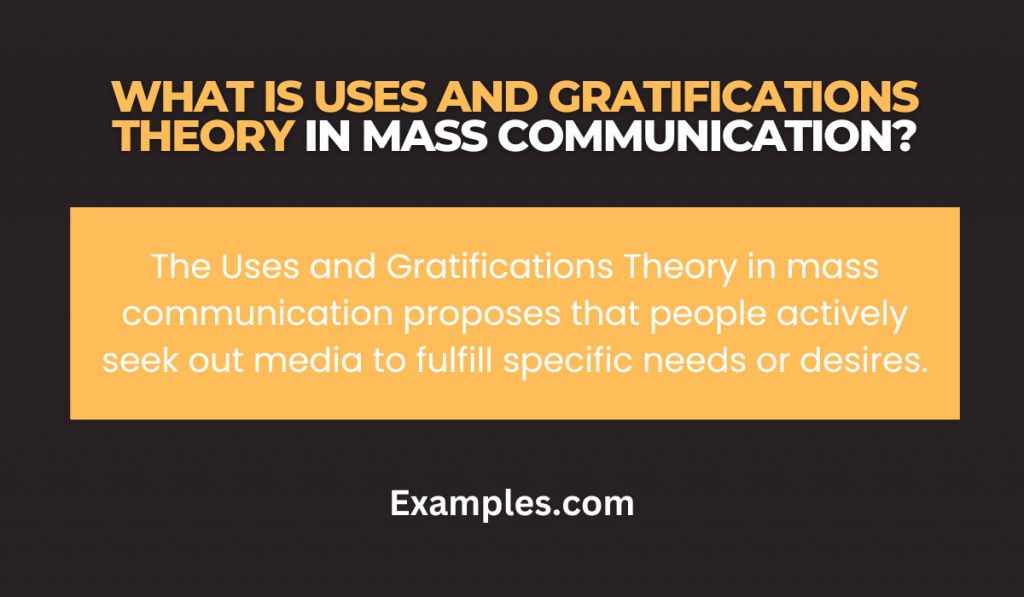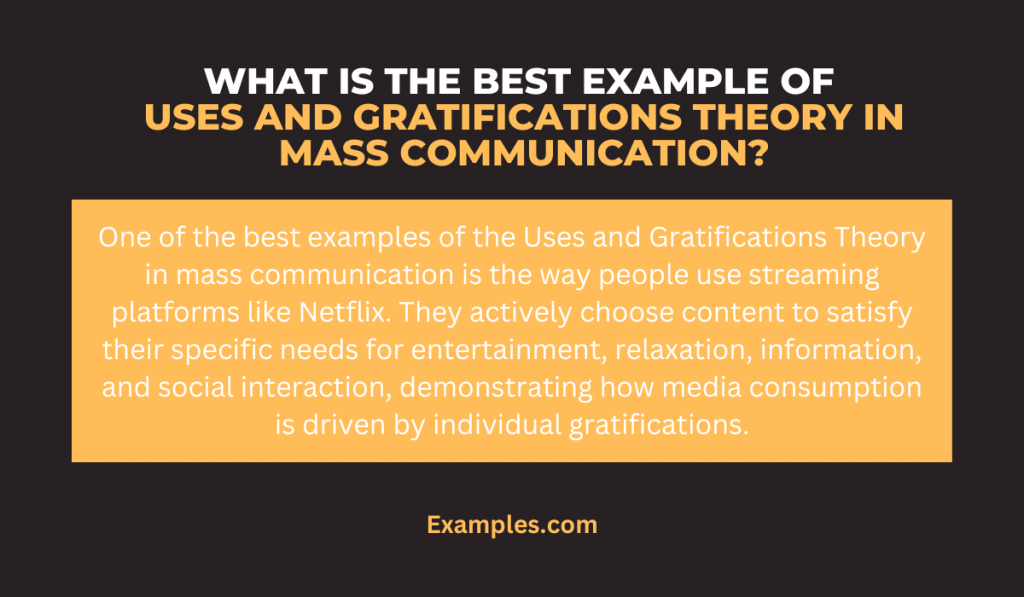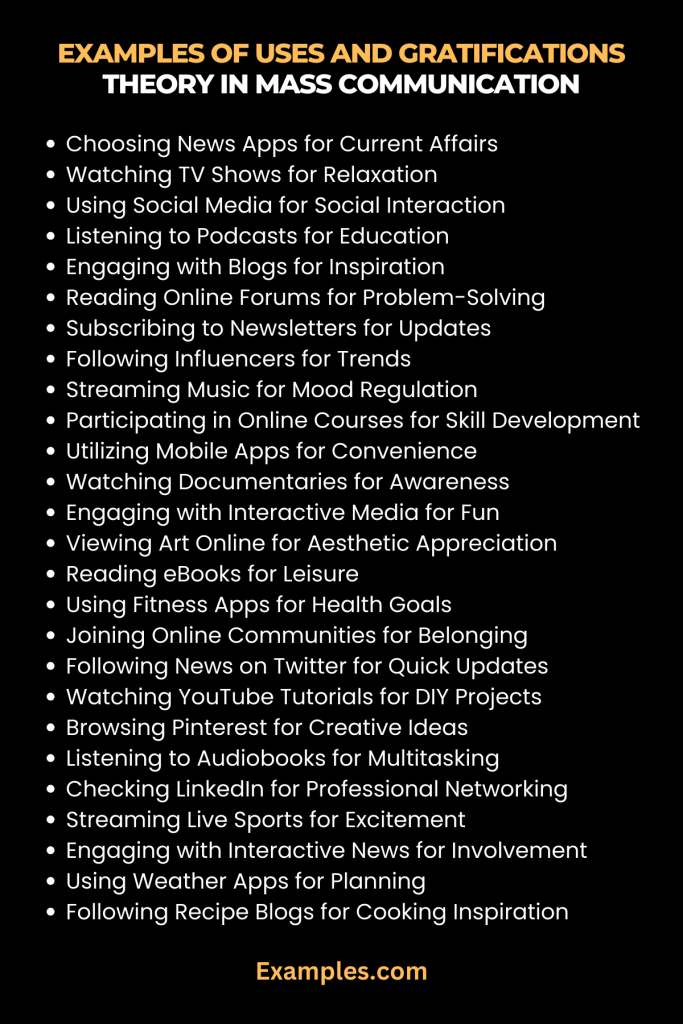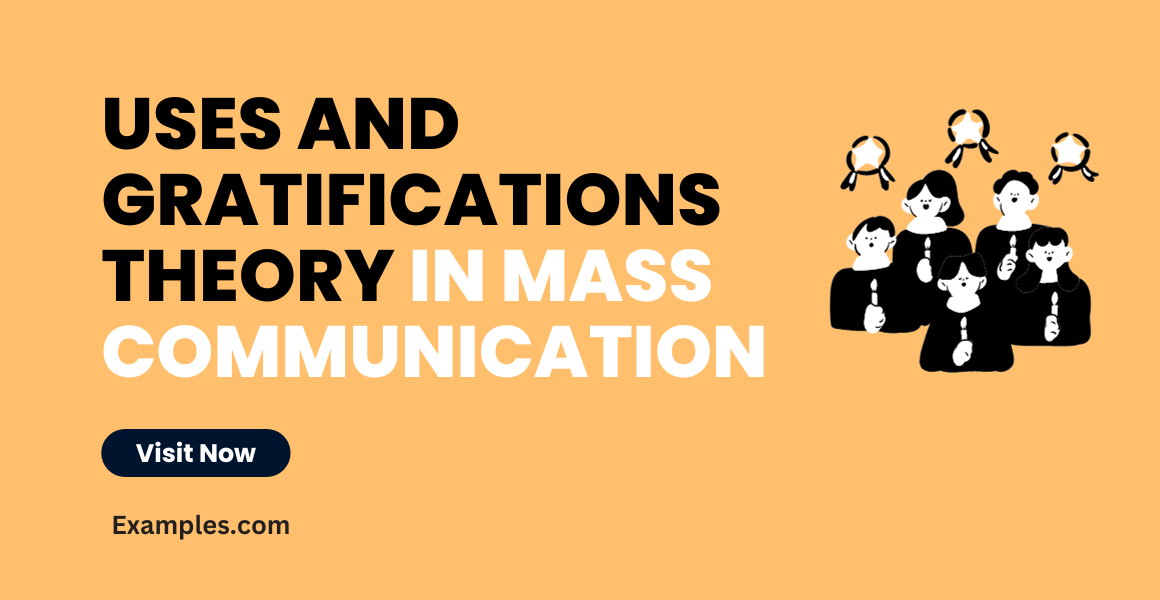29+ Uses and Gratifications Theory in Mass Communication Examples
Discover how the Uses and Gratifications Theory shapes our understanding of Mass Communication. This comprehensive guide delves into real-world applications, demonstrating how individuals actively seek out media to fulfill various needs. From Mass Communication in Advertising to its impact in digital realms, this theory offers a unique lens to view audience-media interactions, providing insightful examples and practical applications in various Mass Communication scenarios.
What is Uses and Gratifications Theory in Mass Communication?
The Uses and Gratifications Theory in mass communication is a concept that explains why people actively seek out specific media to satisfy individual needs. This theory contrasts traditional media theories that suggest the audience is a passive recipient of information. Instead, it emphasizes that people use media for various personal reasons, such as entertainment, information, personal identity, and social integration.
In the context of Mass Communication Examples in Journalism or Social media Mass Communication, this theory implies that audiences are not just absorbing content passively. They are actively selecting what to watch, read, or listen to based on their own desires and needs. For instance, a person might turn to social media for social interaction or watch the news for information. The Uses and Gratifications Theory helps us understand the active role of the audience in the process of mass communication, highlighting the diverse and dynamic nature of media consumption in today’s world.

History
The Uses and Gratifications Theory in mass communication, evolving since the 1940s, has significantly influenced how we understand media consumption. Initially emerging as a response to the Limited Effects Theory, it proposed a more active role of the audience in interpreting media messages. This theory shifted focus from what media does to people, to what people do with media. It emerged as a critical framework during the rise of television, offering insights into the audience’s choice in media consumption based on their psychological and social needs.
What is the Best Example of Uses and Gratifications Theory in Mass Communication?
The Uses and Gratifications Theory in mass communication highlights how audiences actively seek out media to satisfy specific needs and desires. A prime example of this theory in action can be seen in Broadcasting Mass Communication, especially with television news channels.
Television news channels serve as a quintessential example of the Uses and Gratifications Theory. Audiences turn to these channels not just for information or news, but also for personal reasons such as cognitive needs (understanding the world), affective needs (emotional experiences), personal integrative needs (credibility, stability), social integrative needs (family and friends bonding), and tension release needs (escape and entertainment). This theory profoundly underscores the diverse motivations behind media consumption, particularly in the realm of broadcasting, where viewers actively choose channels that align with their specific psychological or social needs.
This approach to understanding media use is crucial in explaining the Mass Communication Scenario/Situation in modern society, where media is not just passively consumed, but actively sought for various personal and social reasons.

30 Examples of Uses and Gratifications Theory in Mass Communication
The Uses and Gratifications Theory in Mass Communication reveals why individuals actively seek specific media to fulfill their needs. It emphasizes audience choice in Mass Communication Examples, highlighting the active role of users in interpreting content. This theory explains diverse Mass Communication Characteristics, showing how different media types serve varied purposes, from entertainment to information.

- Choosing News Apps for Current Affairs: People use news apps to stay updated with world events, demonstrating a need for timely information.
Example: “I regularly check news apps to stay informed about global happenings.” - Watching TV Shows for Relaxation: Television offers entertainment, aiding in relaxation and stress relief.
Example: “After a long day, I unwind by watching my favorite TV show.” - Using Social Media for Social Interaction: Platforms like Facebook or Twitter fulfill the need for social connectivity.
Example: “I use social media to keep in touch with friends and family across the world.” - Listening to Podcasts for Education: Podcasts are a tool for learning and personal growth, catering to educational needs.
Example: “I listen to science podcasts to feed my curiosity about the universe.” - Engaging with Blogs for Inspiration: People follow blogs for creative ideas and inspiration.
Example: “I read travel blogs to get ideas for my next adventure.” - Reading Online Forums for Problem-Solving: Online communities are sources for solutions and advice.
Example: “I visit tech forums to find fixes for my computer issues.” - Subscribing to Newsletters for Updates: Newsletters provide targeted information directly to inboxes.
Example: “I subscribe to health newsletters to get the latest wellness tips.” - Following Influencers for Trends: Social media influencers are a source for the latest trends and lifestyle inspiration.
Example: “I follow fashion influencers to keep up with the newest styles.” - Streaming Music for Mood Regulation: Music streaming services cater to emotional needs, like uplifting mood or relaxation.
Example: “I listen to upbeat music while working out to boost my energy.” - Participating in Online Courses for Skill Development: E-learning platforms fulfill the need for personal and professional development. Example: “I enroll in online courses to enhance my job skills.”
- Utilizing Mobile Apps for Convenience: Apps for shopping, banking, or navigation offer convenience and time-saving.
Example: “I use mobile banking apps for quick transactions.” - Watching Documentaries for Awareness: Documentaries provide insights into real-world issues, satisfying a desire for awareness.
Example: “I watch documentaries to understand different cultural perspectives.” - Engaging with Interactive Media for Fun: Video games and interactive media offer an engaging escape.
Example: “I play video games to enjoy immersive experiences.” - Viewing Art Online for Aesthetic Appreciation: Digital galleries cater to the desire for experiencing beauty and art.
Example: “I browse online art galleries for visual inspiration.” - Reading eBooks for Leisure: E-books fulfill the need for convenient and accessible reading.
Example: “I read novels on my e-reader during my commute.” - Using Fitness Apps for Health Goals: Fitness apps help in tracking and achieving health objectives.
Example: “I use fitness apps to monitor my daily workouts.” - Joining Online Communities for Belonging: Online groups provide a sense of community and belonging.
Example: “I’m part of a gardening community online where we share tips and experiences.” - Following News on Twitter for Quick Updates: Twitter is a platform for quick, real-time news updates.
Example: “I follow journalists on Twitter to get instant news alerts.” - Watching YouTube Tutorials for DIY Projects: YouTube is a resource for learning and executing DIY projects.
Example: “I watch DIY tutorials on YouTube to learn new crafts.” - Browsing Pinterest for Creative Ideas: Pinterest is used for gathering creative and innovative ideas.
Example: “I use Pinterest to get inspiration for home decor.” - Listening to Audiobooks for Multitasking: Audiobooks provide a way to consume literature while multitasking.
Example: “I listen to audiobooks during my daily run.” - Checking LinkedIn for Professional Networking: LinkedIn fulfills the need for professional connections and opportunities.
Example: “I use LinkedIn to network with industry professionals.” - Streaming Live Sports for Excitement: Live sports streaming meets the desire for real-time entertainment.
Example: “I stream football games live to catch all the action as it happens.” - Engaging with Interactive News for Involvement: Interactive news platforms offer a more engaging way to consume news.
Example: “I prefer news apps that allow me to interact with the content.” - Using Weather Apps for Planning: Weather apps assist in daily planning and preparedness.
Example: “I check the weather app every morning to plan my day.” - Following Recipe Blogs for Cooking Inspiration: Recipe blogs are sources for new cooking ideas and techniques.
Example: “I explore recipe blogs to try out new cuisines at home.” - Watching DIY Channels on YouTube for Learning: DIY channels cater to the desire for learning practical skills.
Example: “I watch YouTube channels for home improvement tips.” - Subscribing to Magazines for In-depth Insights: Magazines provide detailed analysis on various topics.
Example: “I subscribe to tech magazines for comprehensive industry insights.” - Using Travel Apps for Exploration: Travel apps help plan adventures and discover new places.
Example: “I rely on travel apps for finding hidden gems during my trips.” - Participating in Webinars for Knowledge Expansion: Webinars offer a platform for learning from experts.
Example: “I attend webinars to gain insights from industry leaders.”
Role of Hypodermic Needle Theory in Mass Communication
The Uses and Gratifications Theory plays a pivotal role in understanding how audiences interact with mass media. This theory diverges from traditional notions that media impacts audiences uniformly, instead suggesting that individuals actively select media sources and content that fulfill specific needs and desires.
Understanding Audience Motivation
At the heart of the Uses and Gratifications Theory is the understanding of audience motivation. This concept revolves around the idea that people use mass communication platforms not merely as passive recipients but as active seekers of content that meets their personal and social needs. This can range from entertainment and information to personal identity and social interaction.
Media Choice and Audience Empowerment
This theory empowers the audience, placing them at the forefront of media interaction. It suggests that consumers have the power to choose from a diverse array of media offerings. This choice is driven by the desire to find content that aligns with individual interests, be it Social media Mass Communication or traditional Broadcasting Mass Communication.
Gratification Needs and Media Usage
Different gratification needs drive media usage under this theory. These needs can be categorized broadly into cognitive (acquiring information, knowledge), affective (emotional, pleasurable experiences), personal integrative (credibility, stability), social integrative (family and friends connection), and tension release (escape from routines/stress).
Application in Modern Mass Communication
In today’s digital age, the Uses and Gratifications Theory is more relevant than ever. With the advent of interactive platforms like social media, the audience’s role in selecting and interpreting media content has intensified. This has implications for Mass Communication in Advertising, where understanding audience motivation is crucial for crafting effective messages.
Impact on Mass Communication Strategies
The theory significantly influences mass communication strategies. Media producers and communicators are increasingly tailoring their content to meet specific audience needs, leading to more segmented and targeted communication strategies. This personalization is evident in sectors like Television Mass Communication and Email Mass Communication, where content is increasingly customized.
Importance of Uses and Gratifications Theory in Mass Communication
The Uses and Gratifications Theory plays a pivotal role in the study and practice of mass communication. This theory, which emerged in the 1970s, revolutionized the understanding of how audiences interact with media. It proposes that individuals actively seek out media to satisfy specific needs and desires. This concept is instrumental in understanding audience behavior and designing media content that resonates with viewers.
Understanding Audience Motivation
One of the key aspects of the Uses and Gratifications Theory is its focus on why people engage with various media. Unlike traditional theories that assumed a passive audience, this theory acknowledges that people have different motivations, such as entertainment, information, personal identity, and social integration. Understanding these motivations is crucial for Mass Communication in Broadcasting and Television Mass Communication, where audience engagement is vital for success.
Shaping Media Strategies
The theory’s emphasis on audience choice has significant implications for media strategies. In the context of Mass Communication in Advertising and Social media Mass Communication, it assists in crafting messages that align with what the audience seeks. This alignment not only enhances viewer satisfaction but also ensures better engagement and effectiveness of the communication.
Influencing Content Creation
The Uses and Gratifications Theory influences how content is created and presented across various media platforms. It encourages content creators to consider the active role of the audience in selecting and interpreting media messages. This perspective is especially relevant in today’s digital age, where Mass Communication Examples in a Digital Age are abundant, and audience preferences are more diverse and dynamic.
Enhancing Media Research
This theory has also enriched media research by providing a framework to study audience behavior. Researchers can better understand the impact of different types of media, such as Blog Mass Communication or Email Mass Communication, by analyzing how and why audiences use these channels. This research is invaluable in adapting to changing media landscapes and audience preferences.
Implications for Mass Communication Education
In the realm of education, the Uses and Gratifications Theory is essential for students pursuing Mass Communication Jobs/Careers. It equips future professionals with a deeper understanding of audience psychology, enabling them to create more effective and engaging media content.
How to use Uses and Gratifications Theory in Mass Communication
Uses and Gratifications Theory in mass communication serves as a pivotal framework for understanding how audiences actively seek out media to satisfy various needs. This theory, contrasting with other media effect theories, emphasizes the audience’s active role in interpreting and integrating media into their lives. By applying this theory, media professionals and scholars can gain deeper insights into audience behavior and media consumption patterns.
Understanding the Audience’s Needs
The first step in applying the Uses and Gratifications Theory is to identify the specific needs of the audience. These needs can range from entertainment and information to personal identity and social integration. Understanding these needs allows media creators to tailor their content to satisfy their audience effectively.
For instance, in Social media Mass Communication, understanding why individuals use specific platforms can guide the creation of more engaging and relevant content. Similarly, in Television Mass Communication, recognizing the audience’s need for escapism or education can shape programming choices.
Segmenting the Audience
Different audience segments use media for various reasons. By segmenting the audience based on their media usage motivations, professionals in fields like Public Relations Mass Communication and Journalism Mass Communication can develop more targeted and effective communication strategies. This segmentation can be based on demographic factors, psychographic profiles, or even behavioral patterns.
Content Creation and Strategy
Incorporating the Uses and Gratifications Theory in content creation involves crafting messages that align with the identified needs of the audience. For example, in Broadcasting Mass Communication, programs can be developed to cater to audiences seeking news, education, or entertainment. Similarly, Blog Mass Communication can focus on niche interests or provide platforms for community building.
Media Choice and Channel Strategy
Understanding the preferred media channels of different audience segments is crucial. Whether it’s traditional media like print and television or digital platforms like social media and email, choosing the right channel is essential for effective communication. This choice is influenced by the audience’s habits, accessibility, and the nature of the content.
Measuring Audience Satisfaction
Finally, measuring how well the media content satisfies audience needs is vital. This can be done through surveys, feedback mechanisms, and analyzing engagement metrics. For instance, in Mass Communication in Advertising, understanding how advertisements meet the viewer’s informational or emotional needs can guide future campaigns.
In understanding the Uses and Gratifications Theory in mass communication, we uncover how audiences actively engage with media to fulfill specific needs. This theory not only highlights the Main Functions of Mass Communication but also emphasizes the proactive role of the audience in the communication process. By analyzing this, one gains insight into effective communication strategies and the evolving dynamics of audience interaction in various media landscapes.



